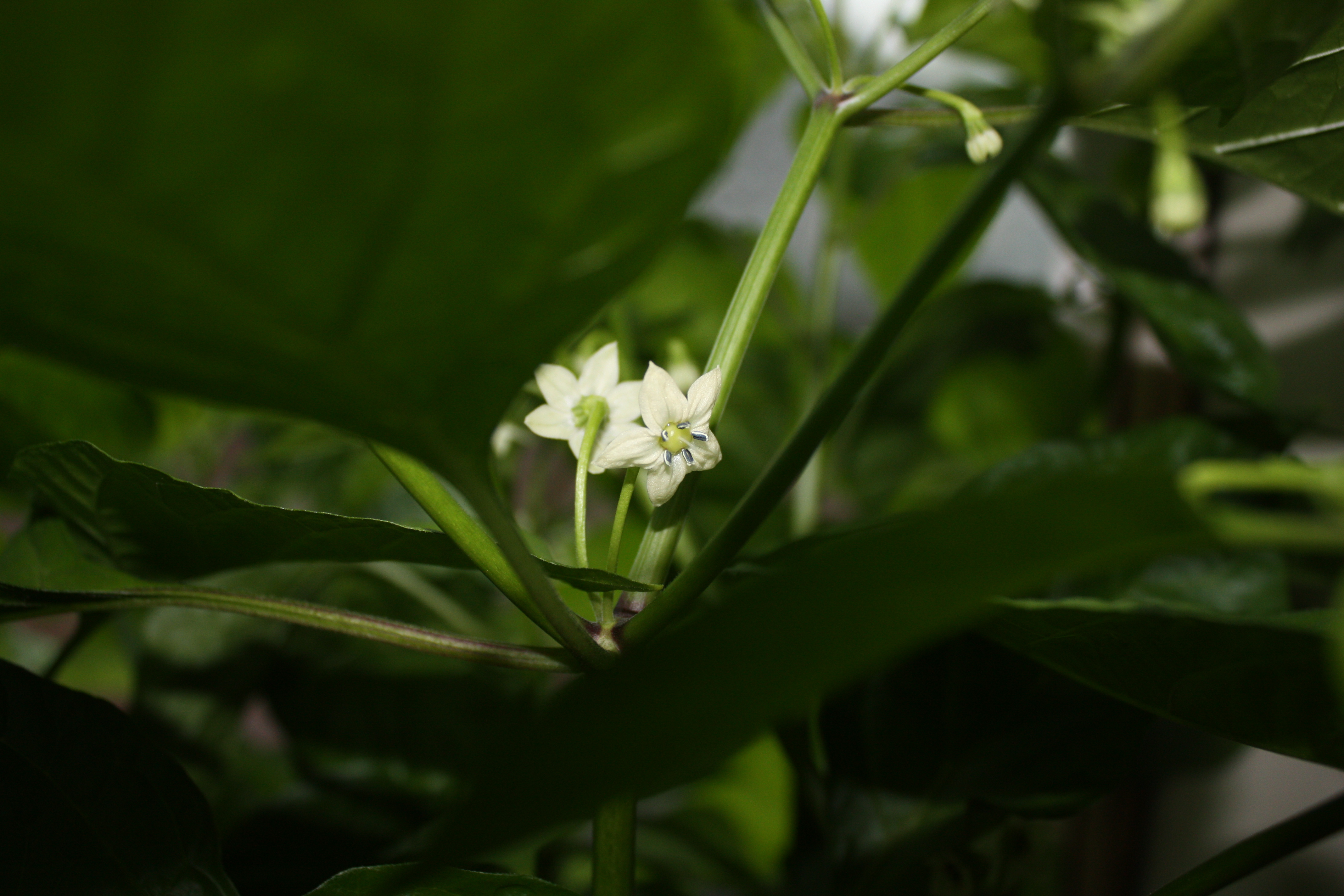|
Habanero Chili
The habanero (; ) is a pungent cultivar of ''Capsicum chinense'' chili pepper. Unripe habaneros are green, and they color as they mature. The most common color variants are orange and red, but the fruit may also be white, brown, yellow, green, or purple. Typically, a ripe habanero is long. Habanero chilis are very hot, rated 100,000–350,000 on the Scoville scale. The habanero heat, flavor, and floral aroma make it a common ingredient in hot sauces and other spicy foods. Name The habanero is named after the Cuban city of ''La Habana'', known in English as Havana, because it used to feature heavily in trading there. (Despite the name, habaneros and other spicy-hot ingredients are rarely used in traditional Cuban cooking.) In English, it is sometimes incorrectly spelled ''habañero'' and pronounced , the tilde being added as a hyperforeignism patterned after jalapeño. Origin and use The habanero chili comes from the Amazon, from which it was spread, reaching Mexico. Today ... [...More Info...] [...Related Items...] OR: [Wikipedia] [Google] [Baidu] |
Capsicum Chinense
''Capsicum chinense'', commonly known as a "habanero-type pepper", is a species of chili pepper native to the Americas. ''C. chinense'' varieties are well known for their unique flavors and, in many cases, exceptional Pungency, heat. The Race to grow the hottest pepper, hottest peppers in the world are members of this species, with a Scoville scale, Scoville heat unit score of 2.69 million measured in the ''C. chinense'' cultivar Pepper X in 2023. Some taxonomists consider ''C. chinense'' to be within the species ''Capsicum annuum, C. annuum,'' and they are a member of the ''C. annuum'' complex; however, ''C. chinense'' and ''C. annuum'' pepper plants can sometimes be distinguished by the number of flowers or fruit per node – two to five for ''C. chinense'' and one for ''C. annuum'' – though this method is not always accurate. The two species can also hybridize and generate inter-specific hybrids. ''Capsicum frutescens, C. frutescens'' may be the ancestor to the ''C. chinense ... [...More Info...] [...Related Items...] OR: [Wikipedia] [Google] [Baidu] |
Colombia
Colombia, officially the Republic of Colombia, is a country primarily located in South America with Insular region of Colombia, insular regions in North America. The Colombian mainland is bordered by the Caribbean Sea to the north, Venezuela to the east and northeast, Brazil to the southeast, Peru and Ecuador to the south and southwest, the Pacific Ocean to the west, and Panama to the northwest. Colombia is divided into 32 Departments of Colombia, departments. The Capital District of Bogotá is also the List of cities in Colombia by population, country's largest city hosting the main financial and cultural hub. Other major urban areas include Medellín, Cali, Barranquilla, Cartagena, Colombia, Cartagena, Santa Marta, Cúcuta, Ibagué, Villavicencio and Bucaramanga. It covers an area of 1,141,748 square kilometers (440,831 sq mi) and has a population of around 52 million. Its rich cultural heritage—including language, religion, cuisine, and art—reflects its history as a co ... [...More Info...] [...Related Items...] OR: [Wikipedia] [Google] [Baidu] |
Bhut Jolokia
The ghost pepper, also known as ''bhut jolokia'' ( or 'Ghost pepper' in Assamese language, Assamese), is an interspecific hybrid chili pepper cultivated in Northeast India. It is a hybrid of ''Capsicum chinense'' and ''Capsicum frutescens''. In 2007, ''Guinness World Records'' certified that the ghost pepper was the world's hottest chili pepper, 170 times hotter than Tabasco sauce. The ghost chili is rated at more than one million Scoville Heat Units (SHUs) and far surpasses the amount of a cayenne pepper. However, in the race to grow the hottest chili pepper, the ghost chili was superseded by the Trinidad Scorpion Butch T pepper in 2011, the Carolina Reaper in 2013 and Pepper X in 2023. Etymology and regional names The name ''bhut jolokia'' means 'Bhutanese pepper' in Assamese language, Assamese; the first element ''bhut'' , meaning 'Bhutanese', was mistakenly confused for a near-homonym ''bhut'' meaning 'ghost'. In Assam, the pepper is also known as ''bih zôlôkia'' me ... [...More Info...] [...Related Items...] OR: [Wikipedia] [Google] [Baidu] |
Carolina Reaper
The Carolina Reaper chili pepper is a cultivar of the ''Capsicum chinense'' plant. Developed by American breeder Ed Currie, the pepper is red and gnarled, with a bumpy texture and small pointed tail. It was the hottest chili pepper in the world according to ''Guinness World Records'' from 2013 to 2023 before it was surpassed by Pepper X, which was also developed by Currie. Development Currie, an American breeder, began working around 2001 on what would become the Carolina Reaper. It took over 10 years to develop. Sorting through hundreds of hybrid combinations, Currie was finally successful at crossing a "really nastily hot" La Soufrière (Saint Vincent) Habanero pepper from the Caribbean island of Saint Vincent and a Naga pepper/ Ghost pepper (locally known as bhüt jolokia) from Assam". During November of that year, a reporter from NPR visited Currie to try the new pepper. According to Currie's website: "The reporter ate a small piece of the pepper, rolled around on the f ... [...More Info...] [...Related Items...] OR: [Wikipedia] [Google] [Baidu] |
Cultivar
A cultivar is a kind of Horticulture, cultivated plant that people have selected for desired phenotypic trait, traits and which retains those traits when Plant propagation, propagated. Methods used to propagate cultivars include division, root and stem cuttings, offsets, grafting, micropropagation, tissue culture, or carefully controlled seed production. Most cultivars arise from deliberate human genetic engineering, manipulation, but some originate from wild plants that have distinctive characteristics. Cultivar names are chosen according to rules of the International Code of Nomenclature for Cultivated Plants (ICNCP), and not all cultivated plants qualify as cultivars. Horticulturists generally believe the word ''cultivar''''Cultivar'' () has two meanings, as explained in ''#Formal definition, Formal definition'': it is a classification category and a taxonomic unit within the category. When referring to a taxon, the word does not apply to an individual plant but to all plants t ... [...More Info...] [...Related Items...] OR: [Wikipedia] [Google] [Baidu] |
Guinness World Records
''Guinness World Records'', known from its inception in 1955 until 1999 as ''The Guinness Book of Records'' and in previous United States editions as ''The Guinness Book of World Records'', is a British reference book published annually, listing world records both of human achievements and the extremes of the natural world. Sir Hugh Beaver created the concept, and twin brothers Norris and Ross McWhirter co-founded the book in London in August 1955. The first edition topped the bestseller list in the United Kingdom by Christmas 1955. The following year the book was launched internationally, and as of the 2025 edition, it is now in its 70th year of publication, published in 100 countries and 40 languages, and maintains over 53,000 records in its database. The international franchise has extended beyond print to include television series and museums. The popularity of the franchise has resulted in ''Guinness World Records'' becoming the primary international source for cata ... [...More Info...] [...Related Items...] OR: [Wikipedia] [Google] [Baidu] |
Pod (fruit)
This page provides a glossary of plant morphology. Botanists and other biologists who study plant morphology use a number of different terms to classify and identify plant organs and parts that can be observed using no more than a handheld magnifying lens. This page provides help in understanding the numerous other pages describing plants by their various taxa. The accompanying page—Plant morphology—provides an overview of the science of the external form of plants. There is also an alphabetical list: Glossary of botanical terms. In contrast, this page deals with botanical terms in a Systematics, systematic manner, with some illustrations, and organized by plant anatomy and function in plant physiology. This glossary primarily includes terms that deal with vascular plants (ferns, gymnosperms and angiosperms), particularly flowering plants (angiosperms). Non-vascular plants (bryophytes), with their different evolutionary background, tend to have separate terminology. Although pl ... [...More Info...] [...Related Items...] OR: [Wikipedia] [Google] [Baidu] |
Scotch Bonnet
Scotch bonnet (also known as Bonney peppers, or Caribbean red peppers) is a variety of chili pepper named for its supposed resemblance to a Scottish tam o' shanter bonnet. It is native to the Americas—a cultivar of '' Capsicum chinense'', which originated in the Amazon Basin, Central and South America. History Indigenous Peoples like the Amerindians of the Antilles, the Tainos and later the Caribs, transported scotch bonnet peppers and other staples like cassava and sweet potato on huge canoes. Both of these Arawakan subgroups originated in the Orinoco River Valley (present-day Venezuela). The Tainos from the Yucatán Peninsula and Belize were pioneers in traveling to the Greater Antilles, and they took a variety of chilies with them. They have since become a staple of Caribbean cuisine, especially Jamaican cuisine. In the 15th and 16th centuries, Spanish and Portuguese colonizers introduced scotch bonnets to other regions. Through the Columbian exchange, the five do ... [...More Info...] [...Related Items...] OR: [Wikipedia] [Google] [Baidu] |
China
China, officially the People's Republic of China (PRC), is a country in East Asia. With population of China, a population exceeding 1.4 billion, it is the list of countries by population (United Nations), second-most populous country after India, representing 17.4% of the world population. China spans the equivalent of five time zones and Borders of China, borders fourteen countries by land across an area of nearly , making it the list of countries and dependencies by area, third-largest country by land area. The country is divided into 33 Province-level divisions of China, province-level divisions: 22 provinces of China, provinces, 5 autonomous regions of China, autonomous regions, 4 direct-administered municipalities of China, municipalities, and 2 semi-autonomous special administrative regions. Beijing is the country's capital, while Shanghai is List of cities in China by population, its most populous city by urban area and largest financial center. Considered one of six ... [...More Info...] [...Related Items...] OR: [Wikipedia] [Google] [Baidu] |
Taxonomy (biology)
In biology, taxonomy () is the science, scientific study of naming, defining (Circumscription (taxonomy), circumscribing) and classifying groups of biological organisms based on shared characteristics. Organisms are grouped into taxon, taxa (singular: taxon), and these groups are given a taxonomic rank; groups of a given rank can be aggregated to form a more inclusive group of higher rank, thus creating a taxonomic hierarchy. The principal ranks in modern use are domain (biology), domain, kingdom (biology), kingdom, phylum (''division'' is sometimes used in botany in place of ''phylum''), class (biology), class, order (biology), order, family (biology), family, genus, and species. The Swedish botanist Carl Linnaeus is regarded as the founder of the current system of taxonomy, having developed a ranked system known as Linnaean taxonomy for categorizing organisms. With advances in the theory, data and analytical technology of biological systematics, the Linnaean system has transfo ... [...More Info...] [...Related Items...] OR: [Wikipedia] [Google] [Baidu] |
California
California () is a U.S. state, state in the Western United States that lies on the West Coast of the United States, Pacific Coast. It borders Oregon to the north, Nevada and Arizona to the east, and shares Mexico–United States border, an international border with the Mexico, Mexican state of Baja California to the south. With almost 40million residents across an area of , it is the List of states and territories of the United States by population, largest state by population and List of U.S. states and territories by area, third-largest by area. Prior to European colonization of the Americas, European colonization, California was one of the most culturally and linguistically diverse areas in pre-Columbian North America. European exploration in the 16th and 17th centuries led to the colonization by the Spanish Empire. The area became a part of Mexico in 1821, following Mexican War of Independence, its successful war for independence, but Mexican Cession, was ceded to the U ... [...More Info...] [...Related Items...] OR: [Wikipedia] [Google] [Baidu] |





